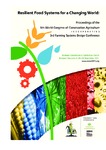Use este identificador para citar ou linkar para este item:
http://www.alice.cnptia.embrapa.br/alice/handle/doc/904475| Título: | Using agro-climatic models to estimate the Guineagrass potential production in Brazilian tropical Savanna. |
| Autoria: | ARAUJO, L. C.  SANTOS, P. M.   RODRIGUES, D.   PEZZOPANE, J. R. M.   CRUZ, P. G.   OLIVEIRA, P. P. A.   |
| Afiliação: | LEANDRO C. ARAUJO, ESALQ/PIRACICABA; PATRICIA MENEZES SANTOS, CPPSE; QUEENSLAND ALLIANCE FOR AGRICULTURE AND FOOD INNOVATION, UNIVERSITY OF QUEENSLAND. PO BOX 102 TOOWOOMBA; JOSE RICARDO MACEDO PEZZOPANE, CPPSE; PEDRO G. CRUZ, ESALQ/PIRACICABA; PATRICIA PERONDI ANCHAO OLIVEIRA, CPPSE. |
| Ano de publicação: | 2011 |
| Referência: | In: WORLD CONGRESS ON CONSERVATION AGRICULTURE, 5.; FARMING SYSTEMS DESIGN CONFERENCE, 3., 2011, Brisbane, Australia. Proceedings... Brisbane: WCCA: FSD, 2011. |
| Páginas: | p.455-456. |
| Conteúdo: | Currently, Brazil has the world?s largest commercial herd of cattle, much of which is raised in extensive grazing farms. The area occupied by pastures in Brazil is approximately 172 million hectares, i.e. 69% of the total area dedicated to agricultural production. Panicum maximum grasses are particularly important in intensive production systems, i.e. irrigated and fertilized, because of their high annual productivity in Brazil?s tropical climate. Managing these intensive systems will require designing robust farming systems and better allocations of limited and increasingly more expensive inputs, in highly variable climates and markets. The development of simulation models that consider the influence of the climate on forage production can facilitate the planning and administration of forage production on the farm. Moreover, simulation models are commonly used to estimate expected changes in climate on the productivity of agricultural systems. Agro-climatic models are, in general, simple to use, require wide available inputs, and can be useful tools for these purposes. When applied in such a specific environment, they can often give more accurate simulations than more complicated and data intensive mechanistic models. In addition, agro-climatic models are often much easier to develop and calibrate than mechanistic models (Teh, 2006). In this paper we parameterized and tested three alternative agro-climatic models, (i) a degree-day model (DDi), (ii) a photo-thermal-units model (PUi), and (iii) a growth climate index model (GCI), to estimate the dry matter production of Panicum maximum cv. Mombaça in São Paulo State, Brazil. |
| NAL Thesaurus: | Panicum |
| Palavras-chave: | Degree day Tropical grass Model |
| Tipo do material: | Artigo em anais e proceedings |
| Acesso: | openAccess |
| Aparece nas coleções: | Artigo em anais de congresso (CPPSE)  |
Arquivos associados a este item:
| Arquivo | Descrição | Tamanho | Formato | |
|---|---|---|---|---|
| PROCI2011.00124.pdf | 1,74 MB | Adobe PDF |  Visualizar/Abrir |









